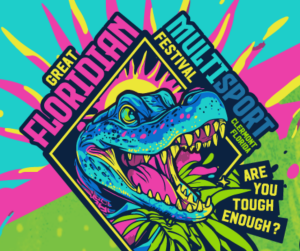GFT Triple Tri Training Tips
The new Great Floridian Triple Triathlon Challenge offers an awesome and unique race format — three sprint triathlons back-to-back! This will require not just speed but also pacing, durability, and smart transitions. Since it’s longer than a sprint but slightly shorter than an Olympic-distance tri, training needs to balance endurance with repeatability. Here are some practical training tips for the average triathlete preparing for the Great Floridian Triple Triathlon Challenge:
General Training Approach
-
Build Endurance Beyond the Total Distance
-
Train for slightly longer than the cumulative distances (e.g., 1–1.2 mile swims, 30–35 mile bikes, and 8–10 mile runs) so the race feels manageable.
-
This ensures you’re not just capable of one sprint, but can sustain energy through three.
-
-
Brick Workouts (Bike → Run, Swim → Bike)
-
Do multi-brick sessions (e.g., swim–bike–run–swim–bike–run) to simulate the repeated transitions.
-
Start with two rounds, then progress to full “triple” simulations in training as you get closer to race day.
-
-
Practice Pacing Discipline
-
Many triathletes go out too hard in a sprint. For three in a row, you’ll need to hold back on sprint #1 so you have energy for #3.
-
Aim for a strong “tempo” effort rather than all-out sprint intensity.
-
-
Transitions Training (T1 & T2)
-
Since you’ll have to do three T1s and three T2s, the time gained/lost adds up.
-
Practice smooth, efficient transitions, focusing on minimal wasted movement.
-
Swim Training
- Include intervals (e.g., 8×100 yards at race pace with short rest) to mimic repeated short efforts.
- Practice sighting and quick exits from the water, since you’ll be doing it multiple times.
- Open-water sessions will help simulate the stress of starting three times.
Bike Training
- Train with low-cadence power intervals to build strength, then follow with steady spinning to recover — simulates race demands.
- Do back-to-back 8–12 mile intervals at race pace with short rests to prepare for the cumulative 24.6 miles.
- Include some bricks where you practice running immediately after multiple short bike efforts.
Run Training
- Focus on running off the bike — your legs will feel heavy multiple times.
- Train with intervals like 3×2 miles at goal pace with jog recovery, simulating the repeated run segments.
- Incorporate strength training for durability (quads, hamstrings, calves).
Nutrition & Hydration
- This race is longer than a typical sprint (likely 3–4 hours total), so fueling matters.
- Practice taking in small amounts of carbs on the bike (30–60g per hour) to keep energy steady.
- Hydrate consistently, especially in Florida heat/humidity.
Race-Specific Simulation
- Do at least 2–3 full triple simulations before race day: swim–bike–run ×3, at slightly lower intensity than race pace.
- Use the same nutrition, transitions, and gear you’ll use in the event.
- This helps with mental prep as much as physical.
Mental Prep
- Think of it as three “mini races” strung together. Mentally reset after each leg rather than thinking of it as one long grind.
- Develop a pacing mantra for each segment (e.g., smooth swim, steady bike, strong run).
✅ Summary: Train like you would for an Olympic triathlon, but with extra emphasis on brick workouts, repeatability, transitions, and pacing. The fitter you are at sustaining controlled intensity, the stronger you’ll finish triathlon #3.


